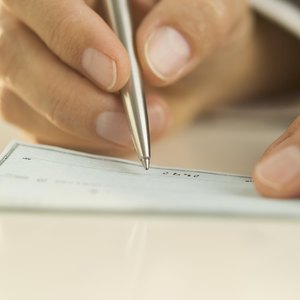
Throughout your life, you might receive a disbursement check – as an investor, employee, small-business owner, heir, member of the military or insurance claim recipient. As technology changes, you’ll be able to cash these financial instruments differently. Reviewing disbursement examples, what disbursement checks are and how to cash them will help you get your money in the quickest, most efficient way possible.
Read More: How to Cash Government Checks
What Is a Disbursement Check?
The word “disbursement,” in financial terms, simply means a payment, explains CheckIssuing.com. A business that reimburses employees for expenses they accrue on behalf of the company use disbursement checks. Dividends can be paid by direct deposit or disbursement checks.
When a deceased person’s estate is settled and the money is paid to everyone in the will and to parties the decedent owed money, the estate’s assets are disbursed. Some lenders release loan funds using multiple disbursements over time, rather than giving the loan recipient all of the money at once, explains investing platform Robinhood.
Read More: How to Endorse Insurance Checks With Co-Payees
The Check-Cashing Process
In addition to depositing a disbursement check into one of your financial accounts, you can also cash it and take the physical money in hand. If you receive a paper check, you will need to endorse it, which consists of writing your name on the back of the check on the line provided for this purpose.
If your business receives a disbursement check, you’ll write the name of the business on the endorsement line, or use an endorsement stamp. Stamps allow businesses that deposit or cash many checks to endorse them by using an inked stamp, rather than having to write the endorsement by hand each time. If a disbursement check is made out to multiple parties, each person will need to endorse the check.
Read More: What Does Less Cash Mean in a Deposit Check?
Ways to Get It Cashed
If you have a bank or credit union account, you can take your check to any branch to cash your (endorsed) check. You’ll need your account number and some form of official ID. In many cases, your bank or credit union will cash the check with no fee.
If you don’t have a bank or credit union account or don’t have a branch near you, you can use another bank, credit union, check-cashing service, retailer or other business that cashes checks. These will usually charge you a fee. They will contact the check issuer or otherwise verify that the check is good before cashing it.
If a bank can’t do that, you won’t be able to cash the check if it’s larger than the amount of money you have in your account. You’ll have to deposit the check, but you can get some cash (equal to what you have in your account) during the transaction. You’ll also need an ID, like a driver’s license or passport.
Depositing a Check
If you don’t want to cash the check and have to carry around the money, you can deposit part or all of the money into one of your financial accounts. You’ll need to fill out a deposit slip and include your name, the amount of the check, your account number along with how much you are depositing and how much of the check you want in cash.
At a bank or credit union, you deposit the check using an ATM, at a branch or using a mobile app. With a mobile app, you’ll need to photograph the front and back of the endorsed check and follow the prompts to make the deposit.
Some of the new “bankless” personal finance apps, like Chime and Mint, might let you deposit the check funds into your account on their platform. Chime provides step-by-step instructions for depositing a paper check, like an IRS refund or government stimulus check.
References
Tips
- You can cash the check at your own bank, but typically only if you have enough money in your account to cover the amount of the check. Your bank effectively gives you an advance on the check and then collects the money from the issuing bank. If the check bounces for any reason, your bank debits your account for an amount equal to the cash that you received.
Warnings
- Some banks charge check cashing fees to noncustomers, and legally banks do not even have to cash checks for non-account-holders. If you cannot cash the check at the bank the funds are drawn against, you can cash it at a check-cashing service, although fees at these businesses are often very high and few states have laws that restrict check-cashing fees.
Writer Bio
Steve Milano has written more than 1,000 pieces of personal finance and frugal living articles for dozens of websites, including Motley Fool, Zacks, Bankrate, Quickbooks, SmartyCents, Knew Money, Don't Waste Your Money and Credit Card Ideas, as well as his own websites.

